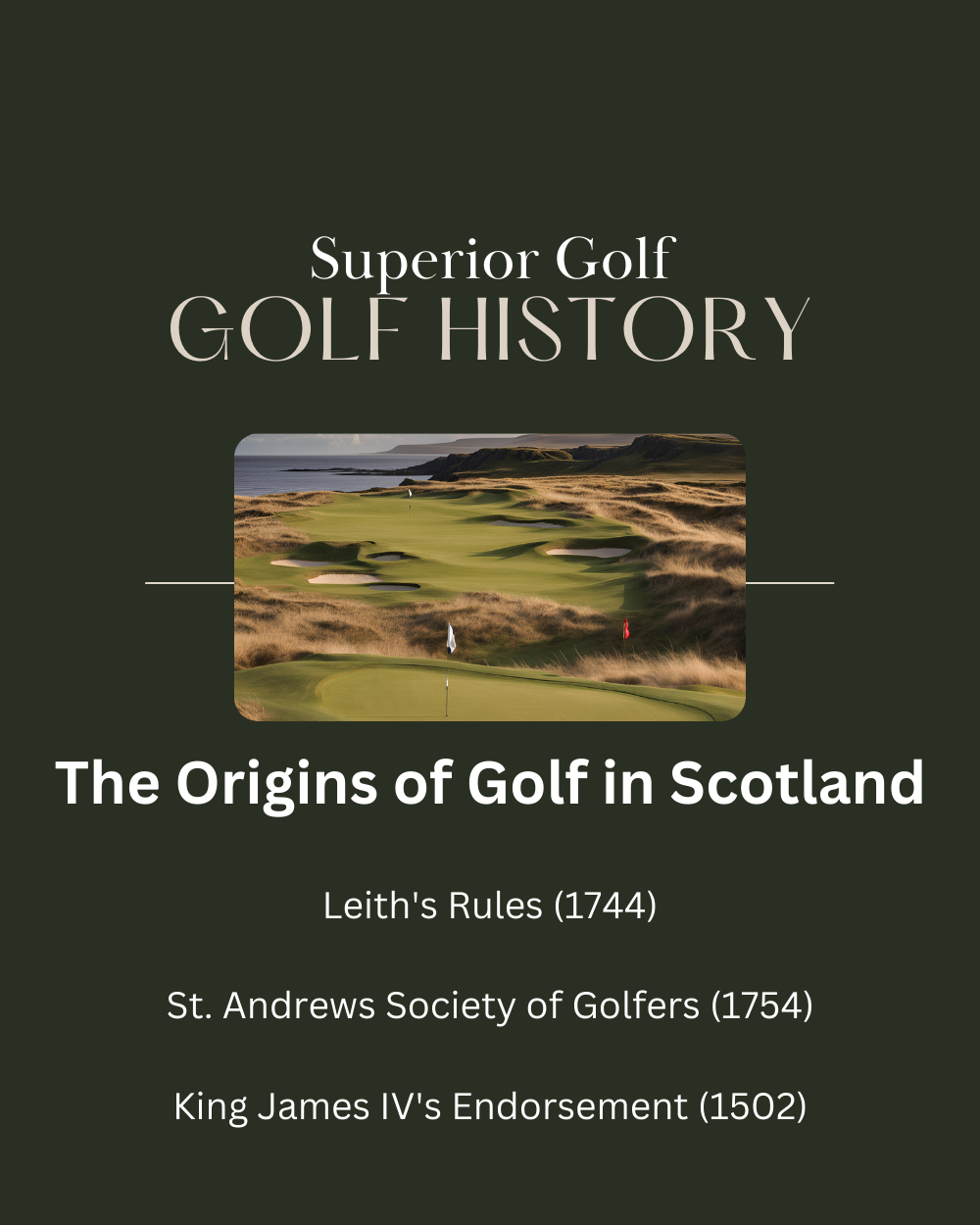The Origins of Golf in Scotland: Golf started on Scotland’s east coast, near Edinburgh. Players used pebbles and bent sticks or clubs1. This sport is a big part of Scotland’s history and culture. Yet, in 1457, Scotland’s parliament, under King James II, banned golf. They thought it distracted from military training1. Despite the ban, golf grew in popularity. By 1502, King James IV of Scotland embraced golf, making him the first golfing monarch1.
This royal support helped golf spread across Europe in the 16th century. Mary Queen of Scots brought golf to France. That’s where we got the word ‘caddie’. In 1682, Leith in Scotland hosted the first international golf match. This event marked Scotland’s key role in golf’s early days.
The Origins of Golf in Scotland Key Takeaways
- Golf originated in Edinburgh, Scotland, highlighting the country’s ancient roots of golf.
- King James II banned golf in 1457, viewing it as a distraction from military training.
- King James IV of Scotland became the world’s first golfing monarch in 1502, giving the sport royal approval.
- Mary Queen of Scots played a key role in spreading golf to France.
- Leith was the site for the first international golf match in 1682, showcasing Scotland’s early golfing history.
The Early History of Golf in Scotland
The story of golf in medieval Scotland is filled with key events that shaped the sport. The creation of the first golf club, the Gentlemen Golfers of Leith, in 1744 marked the start of organized golf. It brought about standard rules for competition1. The mention of St. Andrews in 1552 established its significant role in Scotland’s sports history.
In 1764, St. Andrews Links introduced the 18-hole course. This layout is still the standard worldwide today1. This change was crucial in making St. Andrews Old Course well-known. By 1834, it gained even more fame when King William IV gave it the title ‘Royal & Ancient.’1 This showed golf’s royal support.
Early on, golf clubs and balls were made by hand, which was a detailed job. Stitched horse hide was used for balls. Then, the Industrial Revolution made mass production possible. This change made golf accessible to more people. It moved from handcrafted to widely produced equipment, which helped golf grow fast.
Golf’s roots in Scotland are deep, with clubs like the Gentlemen Golfers of Leith guarding the tradition. The Royal & Ancient Golf Club still shapes golf all over the world today. It reminds us of Scotland’s lasting mark in golf, through both royal backing and the sport’s early structure.
Scotland is home to 587 golf courses, more per person than anywhere else. Most are in Glasgow and Edinburgh2. The Old Course at St Andrews, dating back to before 1574, is a must-visit for golf lovers. It shows how culturally and historically important the sport is in Scotland2.
| Event/Entity | Year | Significance |
|---|---|---|
| First Golf Club – Gentlemen Golfers of Leith | 1744 | Establishment & drafting of competition rules |
| St. Andrews Reference | 1552 | Entry into historical records |
| Creation of 18-hole course at St. Andrews | 1764 | Standardization of the modern golf course |
| Royal & Ancient Golf38839 Club | 1834 | Received ‘Royal’ designation from King William IV |
Development of Rules and Traditions
Scotland has played a huge role in how golf evolved. They started the first golf clubs and courses. The Gentlemen Golfers of Leith were the first to make golf rules that look a lot like today’s, including rules about water hazards. These early rules turned golf from just a hobby into a real sport.
The First Golf Clubs and Courses
Following Leith, the St. Andrews Society of Golfers made their own rules in 1754. Leith’s rules laid the groundwork. Then, St. Andrews added unique elements, enhancing the game. Such efforts show how local traditions shaped golf’s development, just like English common law grew over time.3 The concept of “inventing tradition” means these changes helped connect past and future practices, rooting the game in history4.
| Historic Events | Significance |
|---|---|
| Leith’s Rules (1744) | First codified rules resembling modern golf |
| St. Andrews Society of Golfers (1754) | Adapted and enriched existing rules |
| King James IV’s Endorsement (1502) | Lifted bans and popularized golf |
| International Match at Leith (1682) | Established golf as a recognized sport globally |
Royal Endorsements and Popularity
King James IV was crucial to golf becoming popular. After a peace treaty, he endorsed the game, giving it a big boost. His support showed how important golf was to royalty. This changed how laws and punishments worked in society, making things more organized.3
The royal family, especially Mary Queen of Scots, helped make golf famous. She even introduced it to France, making it known internationally. The 1682 match in Leith showed that golf was recognized worldwide.4 Golf’s rules and traditions have been kept and evolved, showing its long-lasting appeal.
The Origins and Spread of Golf Worldwide
Golf’s journey to global renown began with Scottish expatriates. These Scots started international golf clubs in places like Bangalore, Adelaide, and Montreal. Thanks to them, golf won over hearts in various countries, bridging cultures and societies.
Role of Scottish Expatriates
In the 1800s, Scottish expatriates played a key role in taking golf beyond the British Isles. Their moves, driven by trade and colonialism, helped establish golf in countries like India, Ireland, Canada, and the US. They set up international clubs where the original rules of golf, penned in 1744, were strictly followed. This ensured the same standards of play worldwide5.
Establishment of International Competitions
Starting international competitions also spiked golf’s popularity. In 1860, Prestwick Golf Club held the first event, setting the stage for the British Open. Scotsman Willie Park won, leading to the celebrated British Open we know today. The US Golf Association formed in 1894, quickly uniting 267 clubs by 19105. These events built a competitive spirit in the golf world.
The Scottish not only spread golf to new regions but also influenced mainland Europe. They established key clubs, like the Royal Calcutta Golf Club and the Pau club5. Their love for the game helped golf blend into various cultures, creating a strong, global community of golfers.
Conclusion
Golf turned from a pastime into a major sport in Scotland. Known as the “Home of Golf,” Scotland is celebrated for shaping golf. The famous St. Andrews’ Old Course is a sacred site for golf lovers worldwide6.
Golf in Scotland is for everyone. The country allows easy access to courses, making the game popular across all levels of society. This open approach helps keep golf loved by many7.
Golf started near Edinburgh and became part of Scottish tradition. It grew from simple origins to an international sport. Its history features royal support and legendary matches. Today, golf reflects Scotland’s past and its lively culture7.
Looking at golf’s history shows Scotland’s key role. Scotland’s commitment to golf’s traditions makes it more than a game. It’s a central aspect of Scottish life. Historical documents capture the essence of golf’s story, showing its wide influence678.
FAQ
Where did golf originate?
Why was golf banned in Scotland in 1457?
How did King James IV contribute to the popularity of golf?
What role did Mary Queen of Scots play in the history of golf?
What is the significance of the Gentlemen Golfers of Leith?
Why is St Andrews important in golfing history?
How did golf spread internationally?
What was the first international golf match?
How did the industrial era impact golf?
When was the first competition similar to the British Open held?
How has golf maintained its democratic access in Scotland?
Source Links
- https://www.historic-uk.com/HistoryUK/HistoryofScotland/The-History-of-Golf/
- https://en.wikipedia.org/wiki/Golf_in_Scotland
- https://www.britannica.com/topic/common-law
- https://en.wikipedia.org/wiki/Tradition
- https://collegeofgolf.keiseruniversity.edu/brief-history-golf/
- https://history.ucla.edu/introductions-conclusions/
- https://en.wiktionary.org/wiki/conclusion
- https://academic.oup.com/book/12686/chapter/162706176

